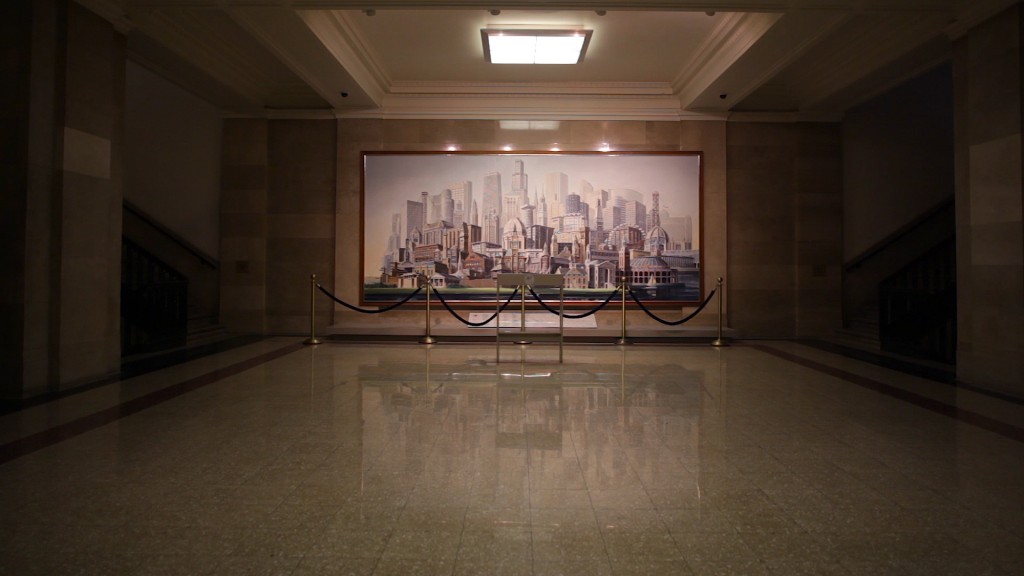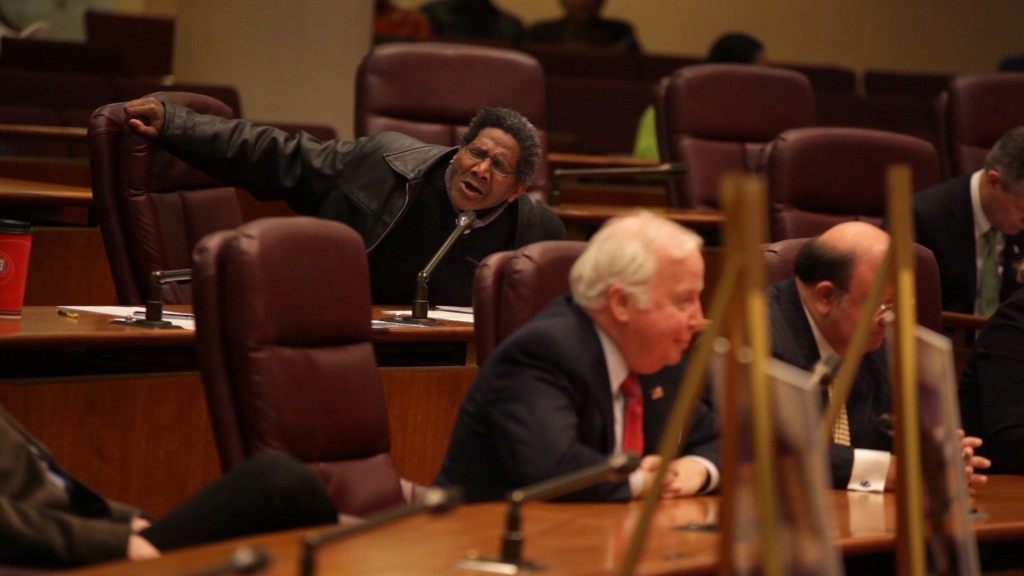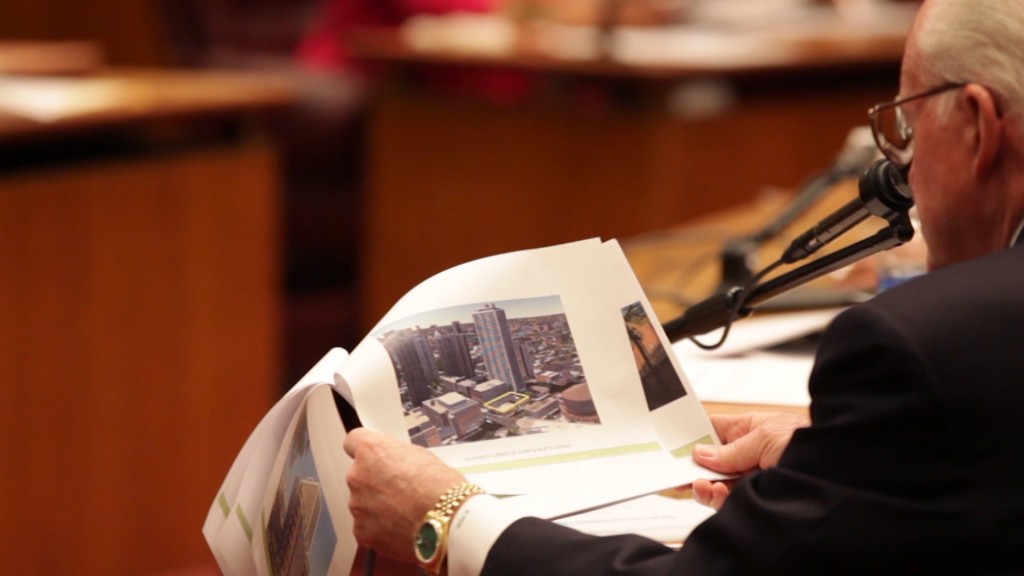In September 2017, Media Burn founder Tom Weinberg and executive director Sara Chapman interviewed the creators of the short film, Open Hearing (2015).
Brian Ashby is a filmmaker and co-founder of Scrappers Film Group. John Corbett is a writer and co-owner of Corbett vs. Dempsey Gallery. Terri Kapsalis is a writer, performer, and cultural critic who teaches at the School of the Art Institute of Chicago.
The film, as well as all the camera original footage of City Hall shot for it, have been preserved by Media Burn and are available online.
Sara Chapman: What was the genesis of this project? It’s very unique that the three parts—images, text, and sound—all seem to be equally important to the effect of the film.
Terri Kapsalis: We wanted to come up with what felt like a truly collaborative way of working. So what we decided at our first meeting was John would be sound, I would be text, Brian, image. For this one it started with my text, which was then handed to Brian. Brian’s job was to create image and then give to John to do sound.
Brian Ashby: It was kind of like an exquisite corpse where one person would have this idea and other people would add to it. This one started from the story of Terri’s.
TK: Yeah, which was a dream, and I had written it years and years and years ago. And Brian said, “Do you have a short piece of text?” And I was like, “Oh there was that weird dream.” So I pulled it out and then he came up with this footage that was just fantastic. I just love how it screws with the text and the layers that it puts on it. And this was made before our current political situation. Politics was crazy before now, of course. But watching it now is like a whole other level.
SC: It was deeply ominous to me, this bureaucracy that makes everything seem sort of normal but takes away all of your power. Just picturing a group of people that would create a mural of a dying set of animals, simply because it was there, just because it was fact, was really chilling to me. And then combined with the way that you put it with images of things that our city had created to memorialize itself. It would never occur to me reading your story to illustrate it that way. But I think it was a really genius combination.

still from Open Hearing
BA: I had been filming in City Hall for a feature-length film I’m working on about the displacement of a community on the South Side. So I was filming in the zoning board to get content for that kind of straightforward documentary, but I was very interested in the mechanics that you could even do that at all, that you would be allowed to do that, and that the press corps aspect had been decolonized, where you didn’t really need a press pass any more because everybody is like a blogger or something. And so you could just hang around and bring your long lens and spy on the people. So I figured I’d do some more of that and see what happens.
I was purposefully going to these meetings that nobody comes to, because I felt like that’s actually where the action is and where important decisions are made. But I thought I’d really like to do a film about City Hall, a Frederick Wiseman-esque film that just looked at the daily life of City Hall. But I was like, I’ll never get access to do that, that’s not going to happen.
But then I got Terri’s text and it sort of just popped into mind, the idea of the wrecked circus. I was like, that sounds like the zoo, it is a very dehumanizing space that kind of makes it seem like people are animals in the zoo. And the idea that, if you leave all these animals unfed they’re going to come back and eat you, describes everything that’s going on right now.
John Corbett: One of the things that’s interesting to me about it is the abstraction of those everyday life situations, because it’s really minutiae from a boring situation and people who are bored to extremes. And so they’re doing what they do and in a super boring situation. They’re talking to one another or fiddling or they’re doing something with their fingers or they’re rocking, or any of those things that happen when you get into a context where you’re depleted of all earthly connection to anything that would keep you engaged. And what I like about it is that then, through editing, but not through quick editing, but by judicious editing–leaving long shots but judiciously choosing when they start and finish–you evince the musicality of the situation.
So the challenge from a musical standpoint was the idea that it should be this particular kind of sound for the tone, that it should be particularly sparse. If you have image track that’s so musical, putting music on it is redundant. So then finding something that could play with it and wouldn’t take away from the inherent musicality of it was what Brian handled so beautifully and what to me is what makes, in an otherwise untenable space, it possible for there to be this text.
It’s very complex to have that many things going on simultaneously in those different registers, and still to be able to follow a narrative like that, that’s kind of an abstract narrative. And that was to me the success of it, it was like at the end of it, you could hear the story, you could see the image and you could hear the sounds and they all felt independent but they all felt like they were doing something together.
And again I go back to the mundaneness or the sense of the quotidian. I get really hung up on things like that. Even that segment where it becomes about whether or not they’re going to make the deadline, that’s about speech and being heard or being suppressed. It becomes some other thing that’s much broader to me.
SC: Yes. This is the time that citizens have in order to make their case about something that’s very important to them. And literally no one is listening to them. People are having their own conversations and few even showed up at all. And you have to fit these very specific things, you have to come on a certain day, you can only speak for a certain number of minutes and even if you fulfill all of these things, presumably there’s no reaction almost ever to any presentation.
Tom Weinberg: They didn’t even turn around.
SC: Right. The only people who are listening are the ones who need to enforce these arbitrary rules about procedure, about how you can present the information.
BA: Yeah. That to me was why I was doing this. What was so fascinating about it to me is that the public is invited into this space and this is the one chance where you could really influence policy on a direct level, this is the room where it happens but it is a theater of power because the only way it works is if you bring hundreds of people with you and you scream really loudly.
SC: Right. And none of the aldermen are even there.
BA: If you go to a zoning testimony and one person presents, the only thing that matters is what the alderman talked about before the meeting, if they decided they would do this or not. So the whole performance is irrelevant most of the time.
SC: Right. Yeah. The idea that a zoning board hearing is when the zoning board decisions get made, that’s absurd. That’s when they’re enacted, the previously decided decisions.

still of a zoning board hearing from Open Hearing
BA: Tom, I was actually very inspired by your film Vito, about Alderman Vito Marzullo, which I saw maybe like 10 years ago. And also by Bill Stamets’ Chicago Politics: A Theatre of Power, which is in your collection. Those two films show the history of this place and the larger than life characters and all that. But I think both of those films were made in these times when if you had a camera you could do what you wanted to and people thought you were special and respected you. Well, that time is over now.
SC: We were also interested in getting involved with you because of the archival aspect of the project. The moment you make a film it becomes archival. Some people don’t always realize it. One of the things that we do at Media Burn is we have completed pieces, but then we also will preserve all of the raw footage, which can become an incredible tool for research, for stepping back in time, for studying culture, politics, history, all sorts of things.
Like Tom’s documentary Vito, there’s maybe 50 hours of it, and we have all of that online and available, too. When we were digitizing it, I did watch a lot of it and that process of sitting in Vito Marzullo’s ward office for hours and hours, watching him at the City Council, just seeing the flood of people coming to him asking for the potholes to be repaired, and for jobs for their brother-in-law, just having all of those hours and hours, seeing what he says in between meetings, seeing how he dresses, seeing how the room is decorated. All of those things give you this way of understanding the past that you can’t really get any other way besides with media footage.
So the fact that Brian also was going to provide the archival footage was very interesting to us because I think that as time passes, it just becomes more and more valuable of a historical resource. And you don’t know which of those people in the room are going to suddenly in ten years have done something significant and that footage will become more interesting. Most people aren’t going to watch the raw footage. But some people might and it might become very useful for something. You just don’t know until the time passes.
BA: I love your guys’ mission and I’ve spent a lot of time in that archive looking at those raw tapes for projects I’m working on. I fear this raw footage it is just not anywhere as interesting as the Vito raw footage.
TK: That’s because it’s now, and not forty years from now.
SC: Many things develop value over time. If you look at an old home movie, the way people dressed back then looks interesting to you in the way that right now it doesn’t look like anything, and all those things just accumulate in value over time.
BA: Somebody may be interested in the zoning variance for the Olive Garden in fifty years and we’ll see.
JC: I love the description of it it’s like…
TK: It’s an Italian cuisine. It’s actually northern Italian Tuscan. To be clear, it’s Tuscan.
BA: Well, he was trying to get through the objections that it’s just a parking lot. You could care about the Tuscan architecture. You weren’t allowed to have this kind of chain restaurant with a huge parking lot in the city of Chicago.
They changed the rules so you could have a place like that. But you had to petition the zoning board. Zoning board’s a very interesting place. It’s like every small thing comes in front of them but also some humongous things just tucked in between a million small things.
But you never know the significance of some random moment. And I definitely found with filming politicians, you don’t know who’s going to go to jail next.
SC: Especially in Chicago.
BA: It’s happened a few times.

still of Alderman Ed Burke at a zoning board hearing from Open Hearing
JC: I knew a picker, he went around and got junk, but really high class junk. And I went tooling around with him a couple times. I was trying to get him to let me write a story about him for the Chicago Reader. He wouldn’t ever relent, but he was so fascinating and so I went over to his house once to look at some things that he had.
So I go to his house and he’s got these two incredible terra cotta lions. He knew the South Side and the West Side, but particularly the South Side, back and forth. And he would drive around and he’d say, “when they tear this building down I’m going to come get that, I’m going to get this, I’m going to get that.” So he’d been looking at these two terra cotta lions that were sconces on a building for a long time. So when the building was going to come down he slipped the contractors some money and he got these lions and took them to his house. His wife wanted them. Because that was always the big thing, whether his wife wanted them or not. Some guy shows up at his door and the woman who was the alderman of that ward said, “if those aren’t on my lawn tonight, you’ll never work in my ward again.” And he was like, “fuck.” So he put them in his truck and he drove them down and put them on her lawn. She wanted them. And she knew where they were. That is some level of deep shit right there.
BA: I was really grateful to these guys for being open to using this stuff and going in this really unexpected direction where we might explore the id of what’s going on in City Hall. It’s boring but it’s ominous, or it’s funny but it’s ominous, or something is happening there that you can’t put your finger on between all the moments when important things seem to happen.
SC: And that you almost can’t stop the progression of. It’s boring and it’s mundane but a lot is happening and it’s just going to go on its own.

1 Comment
We talk, chat, discuss even laugh at what was and still is
wrong, then our drinks or meal comes and in a blink
the chatter changes to other more affable stuff like the bison
burger and carrot fries.
I applaud you who still have the curiosity to find out,
to go and see for yourself and mostly you Tommy,who
reminds me softly that what happened in the
past still is totally relevant .